Sony Reader PRS-T1 Review
Sony Reader PRS-T1
Sony's first UK Wi-Fi Reader looks slicker than Amazon's Kindle. But is it better?
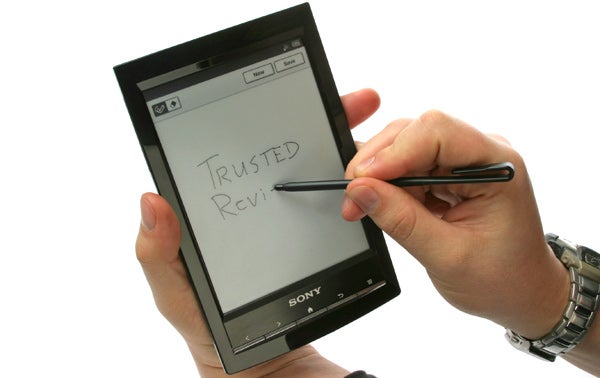
Verdict
Pros
- Multi-touch touchscreen
- Thin and very light
- Great E-ink Pearl screen
Cons
- Reader Store still not open
- No LRF support
- Glossy front annoys
Key Specifications
- Review Price: £129.99
- 6in 800 x 600 E-ink Pearl screen
- Multi-touch touchscreen
- 2GB internal memory
- MicroSD slot
- 3.5mm headphone jack
This latest generation of E-ink readers, populated by the Kobo eReader Touch and 2011 Kindle, has honed the form of the 6in ereader to within an inch or two of perfection. They feel solid but are extremely light and thin. The Sony PRS-T1 fits in completely. If anything, it’s more stylish than either, with a slick, sophisticated look that’s pure Sony.
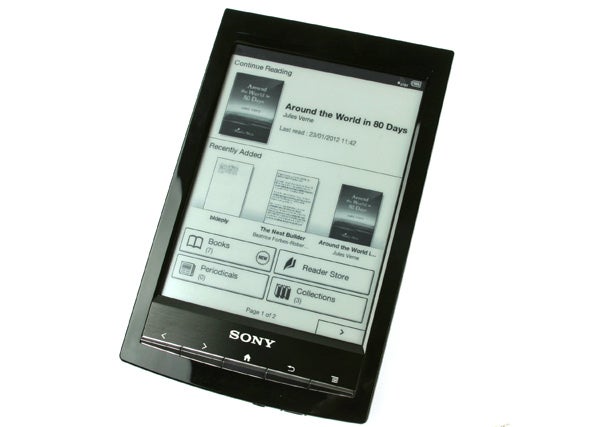
However, long-standing Sony Reader fans may be disappointed to see the use of plastic rather than metal in its construction. The 2008 PRS-505 was mostly metal, the 2011 PRS-650 part-metal, but the PRS-T1 is mostly plastic. There’s a brushed aluminium panel above the nav buttons, to add a spot of sophistication, but the rest of the shell is non-metallic.
This is one reason why the ereader has managed to trim down to 165g, from the 215g of the PRS-650. It is almost exactly the same weight as the current non-touchscreen Kindle.
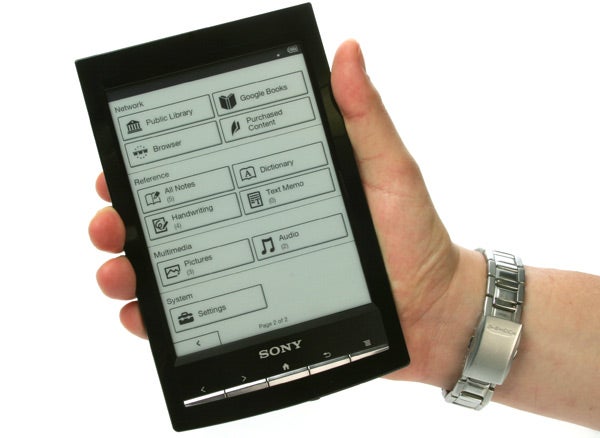
It’s eminently comfortable to hold in one hand, and not only because of its light weight. The PRS-T1’s back has a delightful soft-touch finish that feels smooth, almost silk-like, and is an upgrade over previous Reader models. Sony’s PRS-650 had a deliberate soft-feel finish, but the T1 is that bit better. However, it’s pretty similar to the backs of the latest Kindle and Kobo readers.
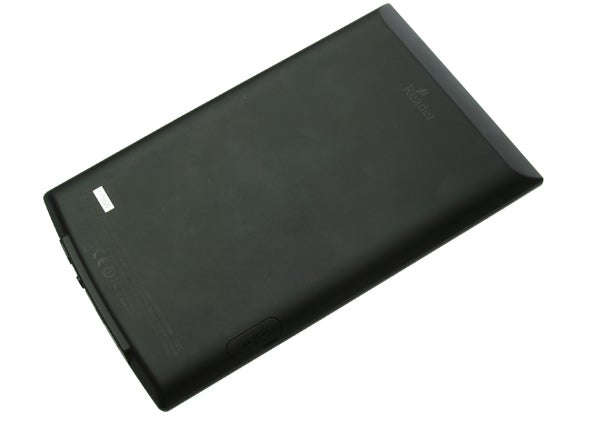
Where the PRS-T1 really does excel is in supplying a few features and connections that are beginning to be left out of some latest-gen ereaders. It offers a microSD card slot on its back to expand upon the 2GB of internal memory and a 3.5mm headphone jack.
You can play music with this reader, but it’s worth considering that you won’t get the advertised one month battery life if you do – a figure based on 30 minutes of reading per day.

This is the first wireless Sony Reader to come to the UK, but there’s also a standard microUSB connection on its bottom edge should you wish to stick to a wired connection. It offers practicality as well as a look that’s more reminiscent of TVs and tablets than traditionally conservative-looking ereaders.
There is a downside to its slick image, though. Black glossy plastic is a poor choice for the front bezel. Most ereaders don’t use grey shades because their designers are interminably dull – it’s so that they fit in better with the slightly greyish look of the E-ink screen.
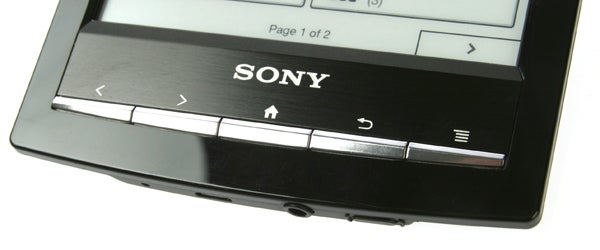
The black here pulls focus a little too much, and when the shiny plastic catches the light it causes distracting reflections. A glossy finish shows off inevitable micro-scratches too, ensuring that the PRS-T1 won’t age as well as a Kobo Touch or Kindle unless you take very good care of it. Sony also offers white and red finishes – and white should prove less of a scene-stealer – but we’d prefer a matt finish.
The Sony PRS-T1 Reader uses an E-ink Pearl screen. This is the same generation of E-ink’s paper-like screen technology seen on all the most popular ereaders currently on sale in the UK. And it still looks great, with greater contrast and improved rendering of text than you’d see in older ereader models.
Most importantly, though, it offers the glare- and eye strain-free surface that makes E-ink readers more desirable as book-replacers than LCD alternatives.
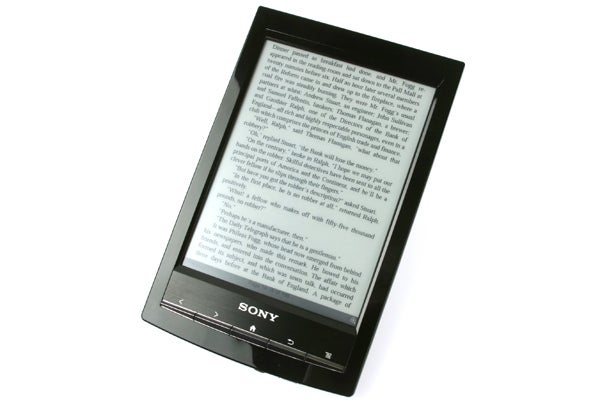
The E-ink Pearl display is capable of rendering 16 shades of grey and has a resolution of 800 x 600 – just like the Kindle and Kobo Touch. Stepping back from the technology a second, Pearl’s contrast remains clearly limited – its white shades still markedly grey – but the reading experience it offers is nevertheless great.
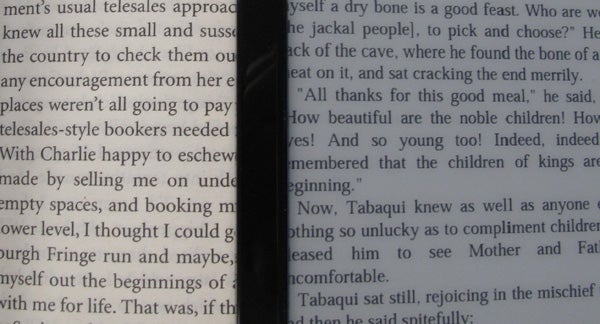
Spreading 800 x 600 pixels over a 6in display, the PRS-T1’s 166dpi “pixel” density doesn’t sound too hot when new smartphones offer 300 dpi, but the nature of E-ink keeps text looking fairly sharp. The images of screens like this are formed of charged black and white microcapsules, giving them a physicality that LCD screens can’t replicate – and a style of pixellation much easier on the eye.
However, higher pixel density is something we’re looking forward to in future waves of ereaders as “real” books printed properly offer much greater sharpness.

Unlike Amazon’s latest Kindle, Sony hasn’t implemented partial screen refreshing as standard here. The Kindle can turn pages much faster than this ereader using partial refresh, but it leaves E-ink residue until a full refresh is performed – which looks bad and can cause headaches.
A full refresh – the black flash that’s an ereader staple – happens at each page turn with the PRS-T1 and page turns aren’t instant, but it’s among the quickest around and on-par with the keyboard’ed Kindle. You can side-step the full refresh by holding down on the page turn button, but this is meant for quickly flicking through a book, not reading.
The panel doesn’t make any great steps forward, but its touchscreen does. Sony uses the same touch technology seen in the PRS-650 and PRS-350, but now it supports multitouch.
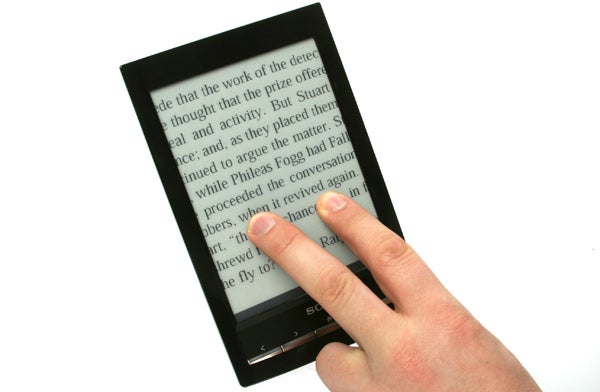
Instead of using a capacitive or resistive surface, the PRS-T1 has an IR (infra-red) based system. Your finger disrupts the IR signal sent across the screen, letting the ereader know where your finger is. That this new one knows where two fingers are at once may sound trivial, but it enables the popular pinch-to-zoom gesture – a major boon for some.
We found it wasn’t all that useful for normal reading sessions, but to navigate around PDFs, it’s a godsend. No more awkward tapping away at zoom buttons, you can zoom about with graceful gestures here. Re-scaling of text takes around half a second, but zooming around is very quick – E-ink isn’t always slow.
Touch control also comes in handy when looking-up words and making notes. Hold a digit down on a word and a UI layer pops-up. The OED definition appears at the bottom of the screen and a series of buttons hovers over the word itself – you can search online for it using Wikipedia or Google, look it up elsewhere in the book, add a note or simply highlight it.
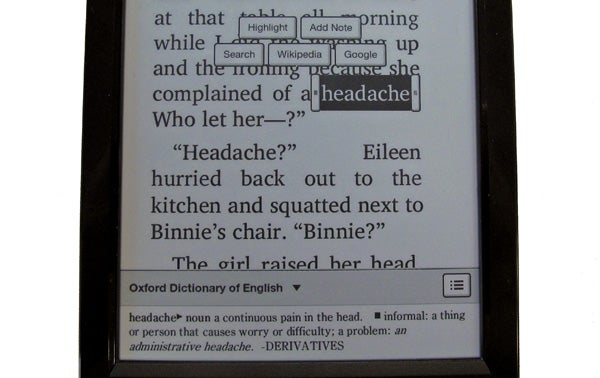
To select more than a single word, you simply drag the little bracket icons at the either end of the selection. This is what may make the Sony PRS-T1 more attractive than the current non-touch UK Kindle to many.
Sony bundles a simple black stylus with the ereader, to make notes with, but there’s nowhere to keep it about the ereader itself. It’s your pocket or nothing, and guarantees plenty of T1 styluses will get lost in sofas and left on buses. You can, however, type in notes using the virtual keyboard rather than the pen.
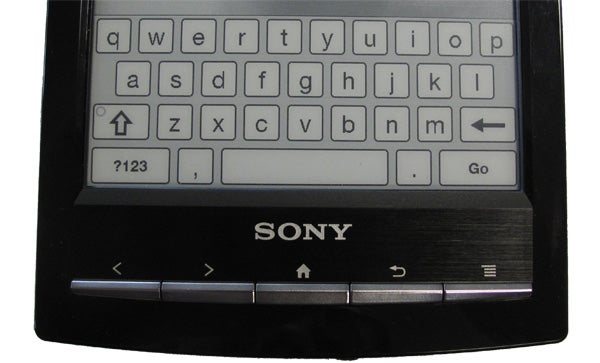
Curiously, although the pinch-zooming feature demonstrates the E-ink screen is capable of quick updates, the PRS-T1 is slow to register text input using the virtual keyboard. You can tap away as fast as you like, but you’ll be waiting for a second or two as the ereader catches up.
The Sony PRS-T1 offers a good spread of font customisation options – especially important if your up-close vision isn’t so hot. There are eight font sizes and seven fonts, ranging from the paperback-apeing “original” to the thoroughly un-book-like Verdana.
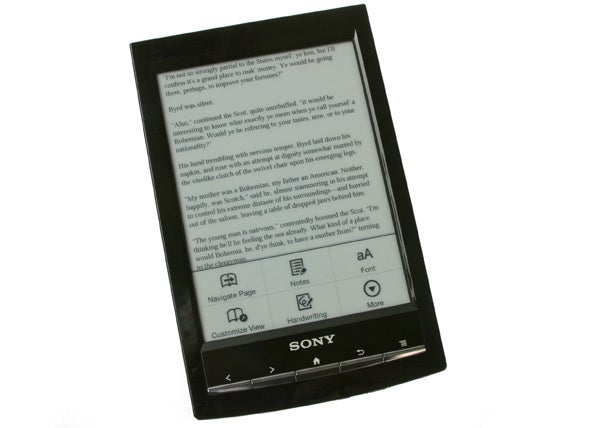
You can access these options at any time when reading with a press on the menu button and a few touchscreen taps. These settings are saved per book, so if you’re sharing the ereader or like your novel fonts looking different from your work doc fonts, that’s no problem. However, we found that some EPUB files refused to change font at all.
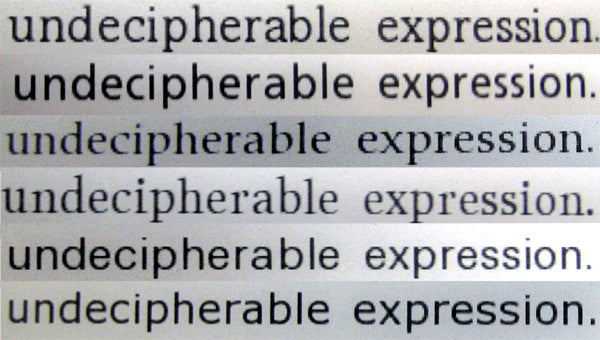
The Sony PRS-T1 also allows altering of the page layout and look. You can split your source page’s width into two or three ereader pages, which comes in very handy if the original text is split into columns, or you can switch to landscape mode. There’s no built-in autorotate function, but having this option nestled within the menu system is useful.

Less useful, but still welcome, is the ability to alter the contrast and brightness of the E-ink screen. In an LCD device, having control over brightness is immensely important. But here it’s not because there is no backlight in an E-ink display.
Altering brightness and contrast simply changes how grey the background is, and how severe the edges of text are. The darkest parts of characters at the default setting are as dark as the screen will allow anyway, and we found the standard setting the most comfortable in day-to-day use.
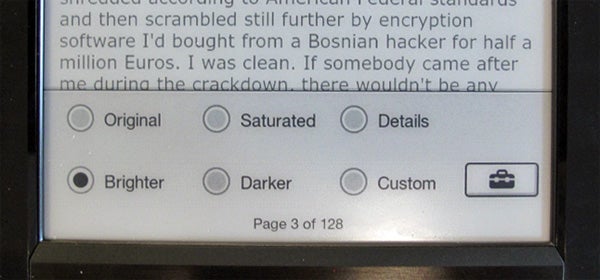
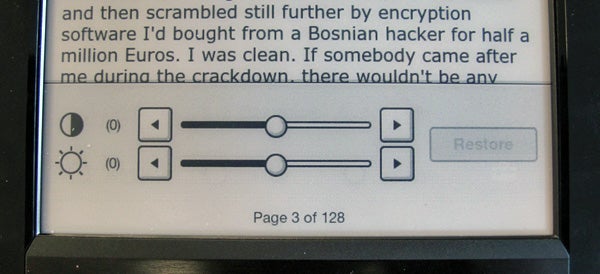
Being able to alter font, font size and screen settings are now staples of big-name ereaders, and the Sony PRS-T1 offers fewer options than some in this regard. The Kobo Touch offers a whopping 25 font sizes, for example. However, in all honesty, there are more than enough options on hand here to satisfy anyone. Still not sated by the line-up? Drop us a comment below.
The Sony PRS-T1 uses an 800MHz Freescale processor, very similar – if not identical – to that found in the Kobo Touch and 2011 Kindle. There is something odd and unexpected under the Sony’s hood, though.
It runs Android version 2.x – the smartphone operating system. You’d never know to look at the user interface, but the little green guy is working his magic under the surface here.
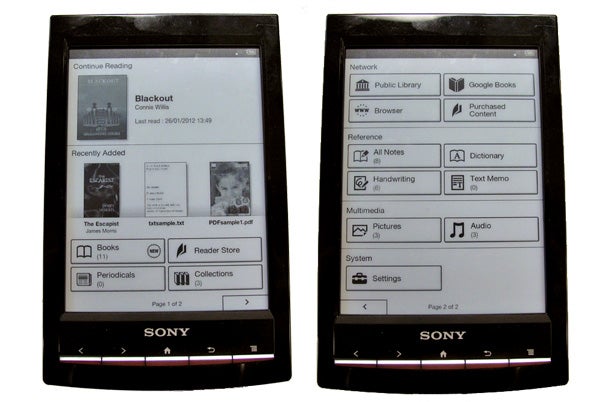
We’re glad to report, though, that there are no widgets, no bizarre customisation options and no Angry Birds on show here. Like all the best ereaders, the PRS-T1’s interface is blessedly simple. Two-thirds of the home screen is given up to your most recently-read book and those just added to the ereader, with four small buttons down at the bottom to take you to your full library, the Reader Store, plus your stashes of periodicals and book collections. For the most part, this screen is all you need.
There is a second interface screen too, which takes you to the settings menu and secondary features like the standalone dictionary, audio player, picture gallery and doodle-fest handwriting app. The Sony PRS-T1 doesn’t include anything we’ve not seen before in readers like the 2010 Kindle and Kobo Touch, but it doesn’t miss out on a great deal either. Except Sudoku – there are no games built-in.
Its Android core suggests there’s potential for more apps to be added later on, but the limited support Sony has given to its Reader range of devices over the years encourages us not to expect too much. As does the current state of its existing functionality. Navigation is a touch slow and the Reader Store book store link takes you to a page telling you that it’s “coming soon” in the UK, which has been its status for several months now.

This is extremely limiting, especially to those who don’t have an existing library of non-DRM ebooks. Once this is fixed, though, the PRS-T1 will offer several ways to buy and download novels and newspapers directly. On top of the official Reader Store, the second page of the main menu offers links to Google Books and your treasure trove of public library book rentals. These are EPUB files with DRM, and as such won’t work with Amazon’s Kindle ebook readers. This is a significant bonus for the Sony, although bear in mind that these limited-time rentals and the book selection isn’t a patch on what you’d get from a full paid ebook store.
You can also transfer ebooks manually over a wired connection. However, it’s a fiddlier process than in previous Sony models. The 2GB of internal memory doesn’t show up as a mass storage drive, just a 10MB setup partition that’s write-protected, stopping transfer of files. Run the setup program on this partition and the PRS-T1 downloads the transfer software from the internet. Not only do you need to install something to transfer files for the first time, you need to be connected to the internet too. Alternatively, you can jam some files onto a microSD card.
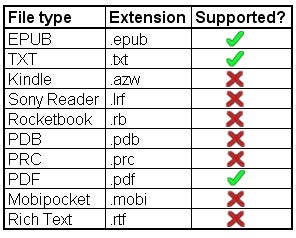
The Sony PRS-T1 supports only a very limited range of ebook types, though. This is primarily an EPUB reader, and Sony’s own proprietary .lrf Reader format is not supported. We’ve never been fans of Sony’s tendency towards proprietary formats and connections, but leaving out this file type is a blunder when previous Sony Reader owners are obvious prospective T1 owners.
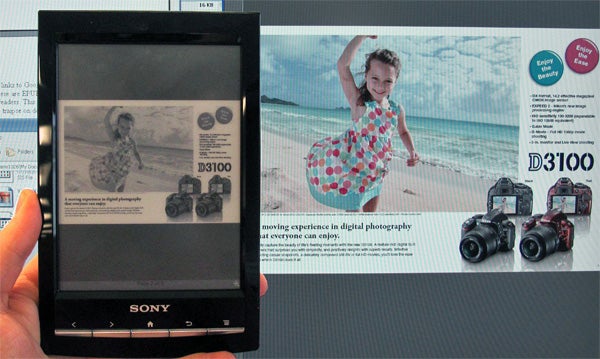
Performance with PDF files is good, though. In our tests, layout and formatting were retained very well and the multi-touch screen makes viewing them far more enjoyable than just about any ereader we’ve tested.
With a touchscreen, stylus and better connectivity than many other ereaders, the Sony PRS-T1 is able to offer a few extra features rivals simply can’t supply. It can play MP3 files, lets you draw pictures and has a web browser.
They are all fairly rudimentary, far outclassed by smartphones and tablets – this is primarily still a one-function device. The built-in music player handles MP3 and AAC files, and has a fairly intuitive interface that incorporates album artwork. However, the output volume of the T1 is pretty low and there’s no speaker on the device. We imagine most buyers of this ereader will have a more competent music player on them most of the time.
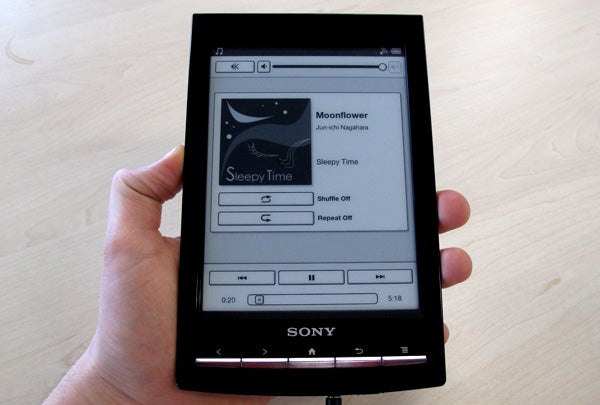
The note-taking app is virtually the same as it was in previous touchscreen PRS-series ereaders. It’s a very basic scribbling tool that gives you a blank screen to draw away on, with an eraser function should you mess up. There are no greyscale painting options, wiping-out its usefulness as an art tool.
However, with a touchscreen and stylus in tow, it would have seemed silly for something like this not to be included. Ideally, we’d like to see OCR (optical character recognition) implemented here and in the mid-read note tool, to make note-taking less of a messy exercise.
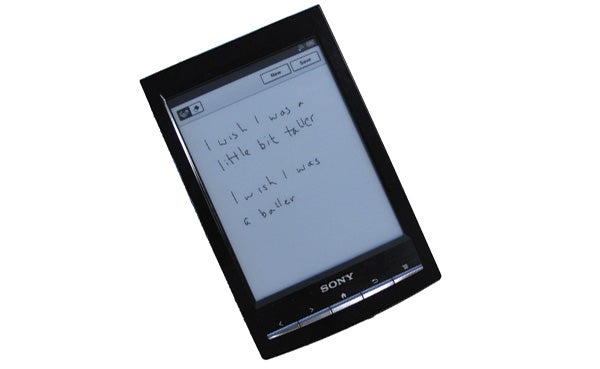
Lastly, there’s the web browser. It suffers from many of the same problems other ereader browsers are afflicted with – slow speed, no Flash support and that it turns the world wide web into an archaic looking monochrome world – but the multi-touch touchscreen makes it far more enjoyable to use than most. Page loading may be slow, but navigating around and zooming in and out is fairly nippy.
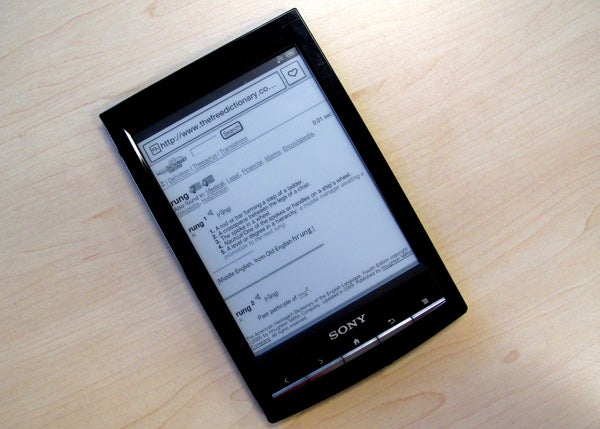
The E-ink display refreshes every time you alight on a new position, meaning you have to wait half a second or so for the image to become nice and sharp following a scroll around. However, it easily beats the experience of using a naff little D-pad to move around, à la keyboard Kindle.
These cherry-on-top extras are unimportant when stacked up against the basic reading experience of an ereader. Which makes all the more annoyed about this model’s distracting glossy black frontage. Having seen a similar design executed using matt plastic in the Kobo Touch, we’re confident the T1 would look just about as snazzy without the shiny finish.
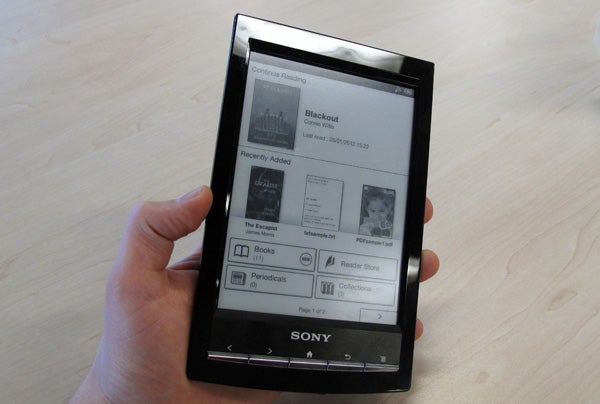
Mmm… shiny (that’s an ironic Mmm)
Some elements of the ereader don’t pay quite enough attention to the end user, another being the lack of LRF support. Yes, it’s a naff format that barely anyone uses anymore, but what about all those Sony Reader veterans who have been fans since 2006 and have built-up substantial .lrf libraries?
Technically, this is an impressive ereader with specs that best many of its rivals. It offers decent connectivity and expandable memory while being as thin and light as the most waif-ish ebook readers you can buy. We think that the inclusion of multi-touch is a sensible addition that’s surprisingly useful. However, if you have no interest in PDF-viewing or web browsing, the almost 50 per cent premium commanded over the £89 Kindle may be a little too great, especially when the online book store isn’t live in the UK yet.
Verdict
The Sony Reader PRS-T1 marks a slight change of direction for Sony’s ereader range. Metal construction is out, replaced by a much lighter and slightly more affordable model that’s roughly as thin and weighty as a Kindle, while packing better connectivity, expandable memory and a touchscreen. It shrugs off the occasionally utilitarian look of ebook readers too, with a glossy black design. However, this can be distracting and there a few serious problems to iron out. The Sony Reader store isn’t yet live in the UK, ruling-out buying books directly, and the lack of legacy support is disappointing.
Trusted Score
Score in detail
-
Value 8
-
Features 8
-
Build Quality 8
-
Design 7


